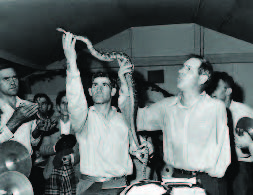

Snake handling at the Church of God with Signs Following at Lejunior in Harlan County, Kentucky, 15 September 1946 (NARA). Photo by Russell Lee.
Pentecostal and Holiness churches that practice snake handling are rethinking their longtime rejection of medical care and belief that it shows a lack of trust in God’s healing powers, writes Julia Duin in National Geographic magazine (February 1). Much of this change in theology has taken place among younger serpent-handling preachers after a number of deaths of leaders in the movement. Ralph Hood, a University of Tennessee scholar studying snake handlers, says that refusing to call 911 is viewed as old-fashioned, with some reasoning that while the Bible might teach serpent handling, there is no prohibition against seeking help for serious bites. David Kimbrough, author of Taking Up Serpents: Snake Handlers of Eastern Kentucky, says theological differences may help explain the various approaches. In Kentucky, snake handlers are trinitarian, conducting baptisms in the name of the Father, the Son, and the Holy Spirit, and they tend to refuse to visit doctors when bitten by a snake. Further south, however, pastors who baptize only in the name of Jesus (Oneness Pentecostals) are more likely to call for help in an emergency. Hood adds that with this compromise the power of the snake-handling message may have been lost: “What meaning does this high-risk behavior have if you’re allowed to go to a doctor for the outcome?” he asks.
Along with the softer message, the younger snake-handling preachers are less strict than their elders. One such preacher, Andrew Hamblin of the Free Pentecostal House of Prayer in Kentucky, is divorced and remarried and welcomes those whom other churches might shun. He has also broken a major taboo by allowing his services to be filmed as part of a reality show, upsetting “many old-time handlers, who felt the program commercialized their beliefs. They preached against the show and have since banned any sort of filming within their churches,” Duin reports. Such critics also claim that many of the media-friendly handlers no longer wait for “God’s anointing”—a bestowal of the Holy Spirit’s presence—before engaging in the practice. Kimbrough says the younger generation needs “to focus more on healing, speaking in tongues, and casting out demons.” Opening church doors to a wider world in the hopes of attracting nonbelievers has been “something of a double-edged sword for many of today’s younger snake-handling preachers,” she adds. One such preacher, saying he had been ridiculed by other Christians, had pulled back from public snake handling. But Duin reports that he had since received a vision to open up his church for “far larger—and better publicized—serpent-handling services. He hoped to begin, he announced on Facebook, as soon as the pandemic was tamed.”
(National Geographic, https://api.nationalgeographic.com/distribution/public/amp/animals/2021/01/snake-handlers-appalachia-changing-practices?)